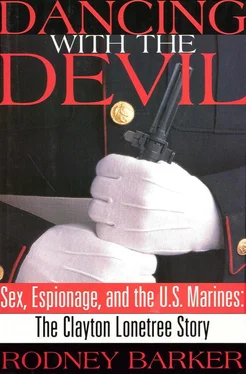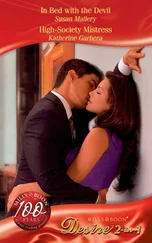But Lonetree had designated Mike Stuhff as lead counsel, and when he instructed Major Henderson not to take an active part in the hearings until they were present, Henderson was put in the awkward position of registering a daily objection to the proceedings on the grounds that civilian counsel were not allowed to be present, then sitting passively by and having to listen to the incriminating testimony of NIS agents who had interviewed Lonetree as it was paraded before the investigating officer by the prosecution.
If what was happening at the Article 32 alerted Major Henderson to civilian counsel’s cynical attitude toward the military justice system, over the next few weeks, as he spent numerous hours with Mike Stuhff and Bill Kunstler discussing defense strategies, he realized that their distrust extended to include military defense lawyers. Fixed in their heads was the notion that military attorneys were not real lawyers because they were more concerned about advancing their careers than being forceful advocates for their clients. What they didn’t understand was that in a military setting military lawyers were often a whole lot more effective than civilian counsels. What they were assuming was that Major Henderson would roll over on his client. What they failed to take into account, because they did not take the time to learn, was that Major Henderson’s once-promising career in the Marine Corps had stalled precisely because of a history of bucking command influence. That was why he was in the defense command, which was attached to the staff judge advocate’s office at Quantico for administration purposes but reported directly to Marine headquarters in Washington, D.C. Major Henderson was a “passed-over Marine” who wasn’t going anywhere in the Corps and knew it, and the only thing that gave him satisfaction was doing his job well.
Feeling on the outs with the rest of the defense team, Major Henderson nevertheless held his peace—until the day William Kunstler called his first press conference. This was a week or so after Kunstler and Stuhff had received their LAA clearances and had been allowed to return to the Article 3 2, and it was held on the lawn in front of Hockmuth Hall. Up until this time the 32 sessions had been closed to the public—none of Lonetree’s relatives had been allowed to attend, nor members of the press. But there had been a strong representation of government spectators from the NIS, State Department, and agencies that did not wish to be identified but had the right badges to get in—so a horde of journalists and cameramen anxious for a progress report showed up, shouting questions and jabbing microphones. This being a first for Henderson, he was blinking at the cameras and paying more attention to the crowd than to civilian counsel when Kunstler’s words filtered through.
“Despite the fact that I have participated in many controversial, and sometimes unfair, criminal trials around the country during most of my professional life, I am profoundly appalled and shocked by what is happening to my client, Sgt. Clayton Lonetree. As his civilian defense counsel I feel utterly compelled to publicize the savagery that is being practiced upon him in a Mephistophelean effort to insure that he is convicted. While I cannot hope to be his Zola [a reference to the French writer whose public defense of Alfred Dreyfus played a major role in reversing the injustice of his arrest], I can at least chronicle some of the evidence to support my thesis that his railroad is running on an express track.”
Kunstler went on to link Lonetree’s prosecution to this country’s disgraceful legacy of racial discrimination against Native Americans, and to proclaim his client’s ultimate innocence, which he, as an American engaged for most of his adult life in the defense of minority persons wrongfully accused of crimes, intended to prove.
Henderson couldn’t believe what he was hearing. How did Kunstler expect to prove his client’s innocence? What exonerating evidence did he have? If he really understood the case and the law, how could he say with a straight face that Lonetree was being prosecuted because he was an Indian? This was a Marine who had admitted to committing serious violations. The Marine Corps wasn’t picking on him because he was an Indian. Let any Marine spy against his country and he was going to be prosecuted.
This was a turning point for Major Henderson. After that press conference he was unable to keep his tactical disagreements with civilian counsel to himself, and he went to the brig to talk the situation over with his client. But when he tried to explain his thinking, it was apparent that civilian counsel had successfully undermined Lonetree’s confidence in anyone wearing a uniform. Civilian counsel had gone in and said, “You can’t trust Henderson because he’s a Marine. You’ve got to listen to us.” And not knowing better, Lonetree had believed them.
Henderson felt like withdrawing from the case. He wanted to say, “Look, Clayton. These guys have taken over, go ahead and go with them. I’d like to be relieved of my duty.” And he knew Lonetree would not have put up an argument.
But he had seen cases where that happened and clients were promptly sacrificed. And by this time he felt a loyalty to his client to the extent that he had to protect and help him in any way he could.
So he told Lonetree that he disagreed with what civilian counsel was doing. He said, “I don’t believe their tactics are in your best interest. But it’s up to you. It’s your decision.”
Lonetree’s response was, “I’m sorry, Major Henderson, but I’m not interested in plea bargaining, because Mr. Kunstler has assured me I’m not going to be convicted.”
• • •
When Michael Stuhff had shown up at the door of Kunstler’s New York City office, 13 Gay Street in Greenwich Village, and said, “Clayton Lonetree has authorized me to invite you back on the case,” William Kunstler had agreed to return for the same reasons he’d been interested in getting involved in the first place. In his eyes the entire American legal system was an enemy and a corrupt tool of the “haves.” He believed that there was bias built into the American system of jurisprudence and that a different set of rules flourished for the rich and powerful in a criminal situation, while people without money or influence went underrepresented and overpunished. His résumé and the cases he’d handled—he referred to them as “professional achievements”—left little doubt the man was on a crusade. From his defense of Martin Luther King, Jr., Adam Clayton Powell, Jr., and Stokely Carmichael to his defense of Daniel Berrigan, he had waged a battle against the establishment, the system, those in power.
And standing shoulder to shoulder with these well-known defendants were some of the biggest and baddest names in Indian America: Dennis Banks and Russell Means, leaders of the American Indian Movement (AIM), arrested at Wounded Knee, South Dakota, in 1974 for conspiracy to take over the town; and Leonard Peltier, convicted of gunning down two FBI agents during that uprising. The case of Sgt. Clayton Lonetree, in William Kunstler’s estimation, was just the latest in a long line of government persecutions of Native Americans. He had yet to inspect the evidence or review the legal issues, but as someone keenly aware of the politics involved in this kind of high-profile case, and a self-appointed authority on racism in the military, he trusted the instincts that told him what was going on here was the unwholesome habit of blaming an individual for the failure of a larger organization. He suspected that Sergeant Lonetree was being overcharged so the Reagan administration could show it was hard on spies, that the NIS was going to outrageous lengths to try to convict this man because his arrest had been an embarrassment to the Marine Corps; and he had no doubt that if Major Henderson had his way, the march to justice for Sgt. Clayton Lonetree would be played out to a military drumbeat.
Читать дальше












